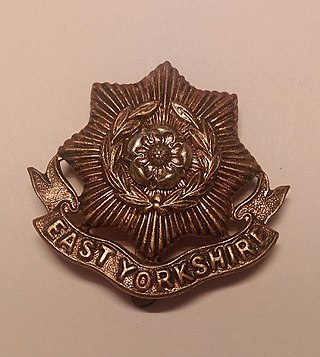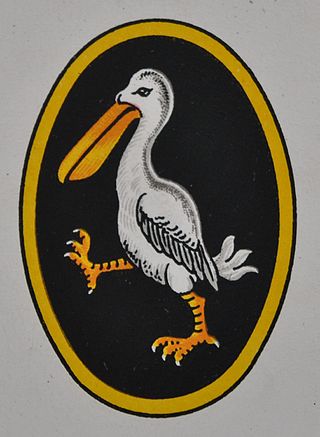Related Research Articles

The 49th Infantry Division was an infantry division of the British Army. The division fought in the First World War in the trenches of the Western Front, in the fields of France and Flanders. During the Second World War, the division fought in the Norwegian Campaign and in North-western Europe. After the Second World War, it was disbanded in 1946, then reformed in 1947. It remained with Northern Command until finally disbanded in 1967.

The Duke of Wellington's Regiment (West Riding) was a line infantry regiment of the British Army, forming part of the King's Division.

The 4th Infantry Division was a regular infantry division of the British Army with a very long history, seeing active service in the Peninsular War and Waterloo Campaign, the Crimean and Boer Wars and both World Wars. It was disbanded after the Second World War and reformed in the 1950s as an armoured formation before being disbanded and reformed again and finally disbanded on 1 January 2012.

The West Riding Artillery was formed as a group of volunteer units of the British Army in 1860. Its units later formed the divisional artillery of the West Riding Division of the Territorial Force in World War I and World War II. The West Riding Artillery's lineage is continued in a battery of today's Army Reserve

The Wiltshire Regiment was a line infantry regiment of the British Army, formed in 1881 under the Childers Reforms by the amalgamation of the 62nd (Wiltshire) Regiment of Foot and the 99th Duke of Edinburgh's (Lanarkshire) Regiment of Foot.

The East Yorkshire Regiment was a line infantry regiment of the British Army, first raised in 1685 as Sir William Clifton's Regiment of Foot and later renamed the 15th Regiment of Foot. It saw service for three centuries, before eventually being amalgamated with the West Yorkshire Regiment in 1958, to form the Prince of Wales's Own Regiment of Yorkshire. Subsequently, the regiment amalgamated with the Green Howards and the Duke of Wellington's Regiment to form the Yorkshire Regiment on 6 June 2006.

The 146th Infantry Brigade was an infantry brigade formation of the British Army, part of the Territorial Force with the 49th Infantry Division. The brigade saw active service during both the First and the Second World Wars, and during the early part of the Cold War. The brigade was active from 1908 until 1967 when it was finally disbanded. The brigade was reformed in 1983, though with a much smaller and insignificant role before finally disbanding again in 1993.

The 147th Infantry Brigade was an infantry brigade of the British Army, part of the Territorial Force, that served in both the First and the Second World Wars with the 49th Infantry Division.

The 62nd Division was an infantry division of the British Army that saw active service on the Western Front during the First World War.
The 164th Brigade was an infantry brigade of the British Army that saw active service in the First World War as part of the 55th Division. As the 164th Infantry Brigade, it remained in the United Kingdom throughout the Second World War, as part of the 55th Infantry Division.
The Liverpool Brigade, later 165th (Liverpool) Brigade was an infantry brigade of Britain's Volunteer Force that served during World War I with the 55th Division of the British Army. During World War II, again as part of the 55th Infantry Division, the brigade remained in the United Kingdom.
The 62nd Brigade was a formation of the British Army. It was raised as part of the new army also known as Kitchener's Army and assigned to the 21st Division and served on the Western Front during the First World War. Brigadier-General George Gater succeeded Brigadier-General C G Rawling as commander of the brigade in November 1917.
The 185th Brigade was a formation of the Territorial Force of the British Army. It was assigned to the 62nd Division and served on the Western Front during the First World War.
The 187th Brigade was a formation of the Territorial Force of the British Army. It was assigned to the 62nd Division and served on the Western Front during the First World War.
The 134th Infantry Brigade was an infantry brigade of the Territorial Force, part of the British Army. It was formed in the First World War as a duplicate of the Hampshire Brigade and was originally formed as the 2nd/1st Hampshire Brigade in 1914–1915 before later being renamed as the 134th Brigade. It was sent overseas to India in December 1914 to relieve Regular Army units for service in France. The brigade remained there for the rest of the war, supplying drafts of replacements to the British units fighting in the Middle East and later complete battalions. By September 1917 the last of its battalions had departed.
The Leeds Rifles was a unit of the 19th century Volunteer Force of the British Army that went on to serve under several different guises in the World Wars of the 20th century. In the First World War, both battalions served as infantry on the Western Front. They were later converted into an anti-aircraft and tank units, and fought in North Africa, Italy, and Burma during the Second World War.

The 148th Infantry Brigade was an infantry brigade formation of the British Army that served in both the First and briefly in the Second World War as part of the 49th Infantry Division and disbanded after the war.
The Huddersfield Rifles was a unit of Britain's Volunteer Force first raised in 1859. It later became a battalion of the Duke of Wellington's Regiment in the Territorial Army, serving as infantry on the Western Front in World War I and as an air defence unit during and after World War II.
The Bradford Rifles was a Volunteer unit of the British Army formed in 1859. It went on to become a battalion of the West Yorkshire Regiment in the Territorial Force and saw action on the Western Front during World War I. Between the wars it converted into an air defence unit, serving during World War II first as a searchlight regiment defending West Yorkshire and later as a garrison battalion in North West Europe. Postwar it continued in the Territorial Army in the air defence role until 1955.

The 5th Battalion, Devonshire Regiment, was a part-time unit of the British Army recruited in the county of Devon. It was formed in the Territorial Force in 1908 by amalgamating two existing Volunteer Battalions of the Devonshire Regiment. The battalion served in India and fought in Palestine and on the Western Front during World War I. In World War II it provided two anti-tank artillery units, which served in Tunisia, Italy and North West Europe. They were both merged into other Devonshire units in 1950.
References
- ↑ "62nd (2nd West Riding) Division". The Long Long Trail. Retrieved 4 February 2012.